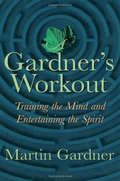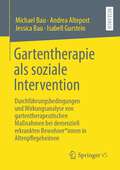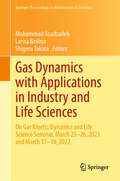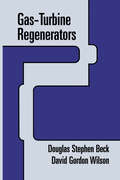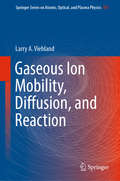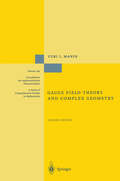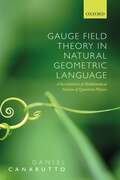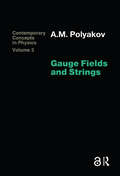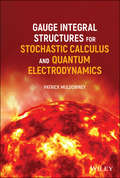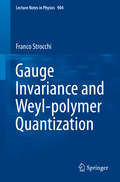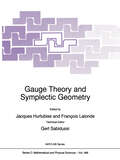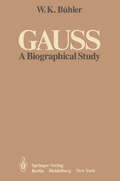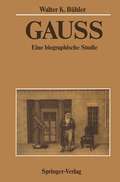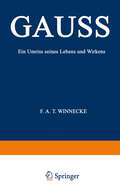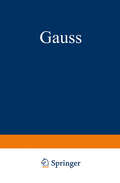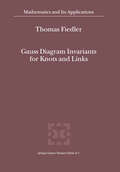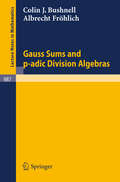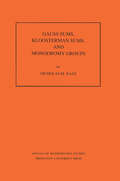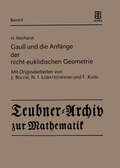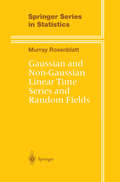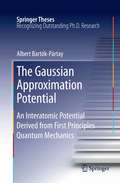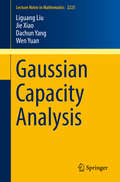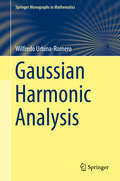- Table View
- List View
A Gardner's Workout: Training the Mind and Entertaining the Spirit
by Martin GardnerFor many decades, Martin Gardner, the Grand Master of mathematical puzzles, has provided the tools and projects to furnish our all-too-sluggish minds with an athletic workout. Gardner's problems foster an agility of the mind as they entertain. This volume presents a new collection of problems and puzzles not previously published in book form. Marti
Gartentherapie als soziale Intervention: Durchführungsbedingungen und Wirkungsanalyse von gartentherapeutischen Maßnahmen bei demenziell erkrankten Bewohner*innen in Altenpflegeheimen
by Andrea Altepost Michael Bau Jessica Bau Isabell GursteinDas ILAG – Institut Leistung Arbeit Gesundheit ist ein interdisziplinär arbeitendes sozialwissenschaftliches Forschungsinstitut und führt seit 2007 Untersuchungen zu Fragen der Gesundheit und zur Veränderung von Arbeit im demografischen und digitalen Wandel durch.
Gas Dynamics with Applications in Industry and Life Sciences: On Gas Kinetic/Dynamics and Life Science Seminar, March 25–26, 2021 and March 17–18, 2022 (Springer Proceedings in Mathematics & Statistics #429)
by Mohammad Asadzadeh Larisa Beilina Shigeru TakataThis proceedings volume gathers selected contributions presented at two instances of the "JSPS/SAC Seminar: On Gas Kinetic/Dynamics and Life Science", held by the Chalmers University of Technology and University of Gothenburg, Sweden, on March 25-26, 2021 (virtual) and March 17-18, 2022 (virtual).Works in this book provide a concise approach to the theoretical and numerical analysis of kinetic type equations that arise, for example, in modeling industrial, medical, and environmental problems. Readers will find some of the most recent theoretical results, newly developed numerical methods in the field, and some open problems. Possible application areas encompass fission/fusion energy, electromagnetics, nuclear science and engineering, medical service, radiation oncology, and plants growth conditions, to name a few. The JSPS/SAC seminars are jointly organized by JSPS (Japan Society for the Promotion of Science)—Stockholm Office and the Department of Mathematical Sciences, Chalmers University of Technology & University of Gothenburg, Sweden. These seminars foster discussions on the mathematical theory, industrial and life science applications, and numerical analysis of non-linear hyperbolic partial differential equations modeling collision-less plasma and charged particles.Chapter 4 is available open access under a Creative Commons Attribution 4.0 International License via link.springer.com.Chapter 11 is available open access under a Creative Commons Attribution 4.0 International License via link.springer.com.
Gas-Turbine Regenerators
by Douglas Beck David G. WilsonRegenerative gas turbines are attractive alternatives to diesel engines and spark ignition engines for automobiles and to diesel engines and combined-cycle en gines for power generation. Theory indicates regenerative gas turbines should achieve higher thermal efficiencies than those of diesel engines and combined cycle engines. Further, regenerative gas turbines are potentially lower in cost, require less maintenance, require less space, and pollute less than competitive systems. Regenerators can be used for exhaust-gas heat exchange or for intercooling in gas-turbine systems. As an exhaust-gas heat exchanger, a regenerator recovers heat from the exhaust and uses it to preheat the compressed air before the compressed air enters the combustor. Preheating of the compressed air permits a small heat input to the combustor for a given power output of the engine. As an intercooler, a regenerator cools the gas between compressor stages. Less work is required to compress cool gas than is required to compress warm gas. Therefore, a regenerator intercooler can reduce the required work input to the compressor. Thus, regenerators can be used to increase the thermal efficiencies and power outputs of gas turbines. the backbones of high-performance re High-performance regenerators are generative gas turbines. In the past, lack of understanding of regenerator per formance has led to sub-optimal engine designs. Now this book gives com prehensive regenerator information. With this book, the designer can design regenerators that will yield gas turbines with maximum thermal efficiencies.
Gaseous Ion Mobility, Diffusion, and Reaction (Springer Series on Atomic, Optical, and Plasma Physics #105)
by Larry A. ViehlandThis book is about the drift, diffusion, and reaction of ions moving through gases under the influence of an external electric field, the gas temperature, and the number density. While this field was established late in the 19th century, experimental and theoretical studies of ion and electron swarms continue to be important in such varied fields as atomic and molecular physics, aeronomy and atmospheric chemistry, gaseous electronics, plasma processing, and laser physics. This book follows in the rigorous tradition of well-known older books on the subject, while at the same time providing a much-needed overview of modern developments with a focus on theory. Graduate students and researchers new to this field will find this book an indispensable guide, particularly those involved with ion mobility spectrometry and the use of ion transport coefficients to test and improve ab initio ion-neutral interaction potentials. Established researchers and academics will find in this book a modern companion to the classic references.
Gauge Field Theory and Complex Geometry (Grundlehren der mathematischen Wissenschaften #289)
by Yuri I. ManinFrom the reviews: "... focused mainly on complex differential geometry and holomorphic bundle theory. This is a powerful book, written by a very distinguished contributor to the field" (Contemporary Physics )"the book provides a large amount of background for current research across a spectrum of field. ... requires effort to read but it is worthwhile and rewarding" (New Zealand Math. Soc. Newsletter) " The contents are highly technical and the pace of the exposition is quite fast. Manin is an outstanding mathematician, and writer as well, perfectly at ease in the most abstract and complex situation. With such a guide the reader will be generously rewarded!" (Physicalia) This new edition includes an Appendix on developments of the last 10 years, by S. Merkulov.
Gauge Field Theory in Natural Geometric Language: A revisitation of mathematical notions of quantum physics
by Daniel CanaruttoGauge Field theory in Natural Geometric Language addresses the need to clarify basic mathematical concepts at the crossroad between gravitation and quantum physics. Selected mathematical and theoretical topics are exposed within a brief, integrated approach that exploits standard and non-standard notions, as well as recent advances, in a natural geometric language in which the role of structure groups can be regarded as secondary even in the treatment of the gauge fields themselves. In proposing an original bridge between physics and mathematics, this text will appeal not only to mathematicians who wish to understand some of the basic ideas involved in quantum particle physics, but also to physicists who are not satisfied with the usual mathematical presentations of their field.
Gauge Fields and Strings
by A. M. PolyakovBased on his own work, the author synthesizes the most promising approaches and ideals in field theory today. He presents such subjects as statistical mechanics, quantum field theory and their interrelation, continuous global symmetry, non-Abelian gauge fields, instantons and the quantam theory of loops, and quantum strings and random surfaces. This book is aimed at postgraduate students studying field theory and statistical mechanics, and for research workers in continuous global theory.
Gauge Fields and Strings
by A. M. PolyakovBased on his own work, the author synthesizes the most promising approaches and ideals in field theory today. He presents such subjects as statistical mechanics, quantum field theory and their interrelation, continuous global symmetry, non-Abelian gauge fields, instantons and the quantam theory of loops, and quantum strings and random surfaces. This book is aimed at postgraduate students studying field theory and statistical mechanics, and for research workers in continuous global theory.
Gauge Integral Structures for Stochastic Calculus and Quantum Electrodynamics
by Patrick MuldowneyA stand-alone introduction to specific integration problems in the probabilistic theory of stochastic calculus Picking up where his previous book, A Modern Theory of Random Variation, left off, Gauge Integral Structures for Stochastic Calculus and Quantum Electrodynamics introduces readers to particular problems of integration in the probability-like theory of quantum mechanics. Written as a motivational explanation of the key points of the underlying mathematical theory, and including ample illustrations of the calculus, this book relies heavily on the mathematical theory set out in the author’s previous work. That said, this work stands alone and does not require a reading of A Modern Theory of Random Variation in order to be understandable. Gauge Integral Structures for Stochastic Calculus and Quantum Electrodynamics takes a gradual, relaxed, and discursive approach to the subject in a successful attempt to engage the reader by exploring a narrower range of themes and problems. Organized around examples with accompanying introductions and explanations, the book covers topics such as: Stochastic calculus, including discussions of random variation, integration and probability, and stochastic processes. Field theory, including discussions of gauges for product spaces and quantum electrodynamics. Robust and thorough appendices, examples, illustrations, and introductions for each of the concepts discussed within. An introduction to basic gauge integral theory. The methods employed in this book show, for instance, that it is no longer necessary to resort to unreliable "Black Box" theory in financial calculus; that full mathematical rigor can now be combined with clarity and simplicity. Perfect for students and academics with even a passing interest in the application of the gauge integral technique pioneered by R. Henstock and J. Kurzweil, Gauge Integral Structures for Stochastic Calculus and Quantum Electrodynamics is an illuminating and insightful exploration of the complex mathematical topics contained within.
Gauge Integral Structures for Stochastic Calculus and Quantum Electrodynamics
by Patrick MuldowneyA stand-alone introduction to specific integration problems in the probabilistic theory of stochastic calculus Picking up where his previous book, A Modern Theory of Random Variation, left off, Gauge Integral Structures for Stochastic Calculus and Quantum Electrodynamics introduces readers to particular problems of integration in the probability-like theory of quantum mechanics. Written as a motivational explanation of the key points of the underlying mathematical theory, and including ample illustrations of the calculus, this book relies heavily on the mathematical theory set out in the author’s previous work. That said, this work stands alone and does not require a reading of A Modern Theory of Random Variation in order to be understandable. Gauge Integral Structures for Stochastic Calculus and Quantum Electrodynamics takes a gradual, relaxed, and discursive approach to the subject in a successful attempt to engage the reader by exploring a narrower range of themes and problems. Organized around examples with accompanying introductions and explanations, the book covers topics such as: Stochastic calculus, including discussions of random variation, integration and probability, and stochastic processes. Field theory, including discussions of gauges for product spaces and quantum electrodynamics. Robust and thorough appendices, examples, illustrations, and introductions for each of the concepts discussed within. An introduction to basic gauge integral theory. The methods employed in this book show, for instance, that it is no longer necessary to resort to unreliable "Black Box" theory in financial calculus; that full mathematical rigor can now be combined with clarity and simplicity. Perfect for students and academics with even a passing interest in the application of the gauge integral technique pioneered by R. Henstock and J. Kurzweil, Gauge Integral Structures for Stochastic Calculus and Quantum Electrodynamics is an illuminating and insightful exploration of the complex mathematical topics contained within.
Gauge Invariance and Weyl-polymer Quantization (Lecture Notes in Physics #904)
by Franco StrocchiThe book gives an introduction to Weyl non-regular quantization suitable for the description of physically interesting quantum systems, where the traditional Dirac-Heisenberg quantization is not applicable. The latter implicitly assumes that the canonical variables describe observables, entailing necessarily the regularity of their exponentials (Weyl operators). However, in physically interesting cases -- typically in the presence of a gauge symmetry -- non-observable canonical variables are introduced for the description of the states, namely of the relevant representations of the observable algebra.In general, a gauge invariant ground state defines a non-regular representation of the gauge dependent Weyl operators, providing a mathematically consistent treatment of familiar quantum systems -- such as the electron in a periodic potential (Bloch electron), the Quantum Hall electron, or the quantum particle on a circle -- where the gauge transformations are, respectively, the lattice translations, the magnetic translations and the rotations of 2π. Relevant examples are also provided by quantum gauge field theory models, in particular by the temporal gauge of Quantum Electrodynamics, avoiding the conflict between the Gauss law constraint and the Dirac-Heisenberg canonical quantization. The same applies to Quantum Chromodynamics, where the non-regular quantization of the temporal gauge provides a simple solution of the U(1) problem and a simple link between the vacuum structure and the topology of the gauge group.Last but not least, Weyl non-regular quantization is briefly discussed from the perspective of the so-called polymer representations proposed for Loop Quantum Gravity in connection with diffeomorphism invariant vacuum states.
Gauge Theory and Symplectic Geometry (Nato Science Series C: #488)
by Gert SabidussiGauge theory, symplectic geometry and symplectic topology are important areas at the crossroads of several mathematical disciplines. The present book, with expertly written surveys of recent developments in these areas, includes some of the first expository material of Seiberg-Witten theory, which has revolutionised the subjects since its introduction in late 1994. Topics covered include: introductions to Seiberg-Witten theory, to applications of the S-W theory to four-dimensional manifold topology, and to the classification of symplectic manifolds; an introduction to the theory of pseudo-holomorphic curves and to quantum cohomology; algebraically integrable Hamiltonian systems and moduli spaces; the stable topology of gauge theory, Morse-Floer theory; pseudo-convexity and its relations to symplectic geometry; generating functions; Frobenius manifolds and topological quantum field theory.
Gauss: A Biographical Study
by W. K. BühlerProcreare iucundum, sed parturire molestum. (Gauss, sec. Eisenstein) The plan of this book was first conceived eight years ago. The manuscript developed slowly through several versions until it attained its present form in 1979. It would be inappropriate to list the names of all the friends and advisors with whom I discussed my various drafts but I should like to mention the name of Mr. Gary Cornell who, besides discussing with me numerous details of the manuscript, revised it stylistically. There is much interest among mathematicians to know more about Gauss's life, and the generous help I received has certainly more to do with this than with any individual, positive or negative, aspect of my manuscript. Any mistakes, errors of judgement, or other inadequacies are, of course, the author's responsi bility. The most incisive and, in a way, easiest decisions I had to make were those of personal taste in the choice and treatment of topics. Much had to be omitted or could only be discussed in a cursory way.
Gauss Diagram Invariants for Knots and Links (Mathematics and Its Applications #532)
by T. FiedlerGauss diagram invariants are isotopy invariants of oriented knots in- manifolds which are the product of a (not necessarily orientable) surface with an oriented line. The invariants are defined in a combinatorial way using knot diagrams, and they take values in free abelian groups generated by the first homology group of the surface or by the set of free homotopy classes of loops in the surface. There are three main results: 1. The construction of invariants of finite type for arbitrary knots in non orientable 3-manifolds. These invariants can distinguish homotopic knots with homeomorphic complements. 2. Specific invariants of degree 3 for knots in the solid torus. These invariants cannot be generalized for knots in handlebodies of higher genus, in contrast to invariants coming from the theory of skein modules. 2 3. We introduce a special class of knots called global knots, in F x lR and we construct new isotopy invariants, called T-invariants, for global knots. Some T-invariants (but not all !) are of finite type but they cannot be extracted from the generalized Kontsevich integral, which is consequently not the universal invariant of finite type for the restricted class of global knots. We prove that T-invariants separate all global knots of a certain type. 3 As a corollary we prove that certain links in 5 are not invertible without making any use of the link group! Introduction and announcement This work is an introduction into the world of Gauss diagram invariants.
Gauss Sums and p-adic Division Algebras (Lecture Notes in Mathematics #987)
by C. J. Bushnell A. FröhlichGauss Sums, Kloosterman Sums, and Monodromy Groups. (AM-116), Volume 116
by Nicholas M. KatzThe study of exponential sums over finite fields, begun by Gauss nearly two centuries ago, has been completely transformed in recent years by advances in algebraic geometry, culminating in Deligne's work on the Weil Conjectures. It now appears as a very attractive mixture of algebraic geometry, representation theory, and the sheaf-theoretic incarnations of such standard constructions of classical analysis as convolution and Fourier transform. The book is simultaneously an account of some of these ideas, techniques, and results, and an account of their application to concrete equidistribution questions concerning Kloosterman sums and Gauss sums.
Gauß und die Anfänge der nicht-euklidischen Geometrie (Teubner-Archiv zur Mathematik #4)
by H. ReichardtGaussian and Non-Gaussian Linear Time Series and Random Fields (Springer Series in Statistics)
by Murray RosenblattThe principal focus here is on autoregressive moving average models and analogous random fields, with probabilistic and statistical questions also being discussed. The book contrasts Gaussian models with noncausal or noninvertible (nonminimum phase) non-Gaussian models and deals with problems of prediction and estimation. New results for nonminimum phase non-Gaussian processes are exposited and open questions are noted. Intended as a text for gradutes in statistics, mathematics, engineering, the natural sciences and economics, the only recommendation is an initial background in probability theory and statistics. Notes on background, history and open problems are given at the end of the book.
The Gaussian Approximation Potential: An Interatomic Potential Derived from First Principles Quantum Mechanics (Springer Theses)
by Albert Bartók-PártaySimulation of materials at the atomistic level is an important tool in studying microscopic structures and processes. The atomic interactions necessary for the simulations are correctly described by Quantum Mechanics, but the size of systems and the length of processes that can be modelled are still limited. The framework of Gaussian Approximation Potentials that is developed in this thesis allows us to generate interatomic potentials automatically, based on quantum mechanical data. The resulting potentials offer several orders of magnitude faster computations, while maintaining quantum mechanical accuracy. The method has already been successfully applied for semiconductors and metals.
Gaussian Capacity Analysis (Lecture Notes in Mathematics #2225)
by Liguang Liu Jie Xiao Dachun Yang Wen YuanThis monograph develops the Gaussian functional capacity theory with applications to restricting the Gaussian Campanato/Sobolev/BV space. Included in the text is a new geometric characterization of the Gaussian 1-capacity and the Gaussian Poincaré 1-inequality. Applications to function spaces and geometric measures are also presented. This book will be of use to researchers who specialize in potential theory, elliptic differential equations, functional analysis, probability, and geometric measure theory.
Gaussian Harmonic Analysis (Springer Monographs in Mathematics)
by Wilfredo Urbina-RomeroAuthored by a ranking authority in Gaussian harmonic analysis, this book embodies a state-of-the-art entrée at the intersection of two important fields of research: harmonic analysis and probability. The book is intended for a very diverse audience, from graduate students all the way to researchers working in a broad spectrum of areas in analysis. Written with the graduate student in mind, it is assumed that the reader has familiarity with the basics of real analysis as well as with classical harmonic analysis, including Calderón-Zygmund theory; also some knowledge of basic orthogonal polynomials theory would be convenient. The monograph develops the main topics of classical harmonic analysis (semigroups, covering lemmas, maximal functions, Littlewood-Paley functions, spectral multipliers, fractional integrals and fractional derivatives, singular integrals) with respect to the Gaussian measure. The text provide an updated exposition, as self-contained as possible, of all the topics in Gaussian harmonic analysis that up to now are mostly scattered in research papers and sections of books; also an exhaustive bibliography for further reading. Each chapter ends with a section of notes and further results where connections between Gaussian harmonic analysis and other connected fields, points of view and alternative techniques are given. Mathematicians and researchers in several areas will find the breadth and depth of the treatment of the subject highly useful.
